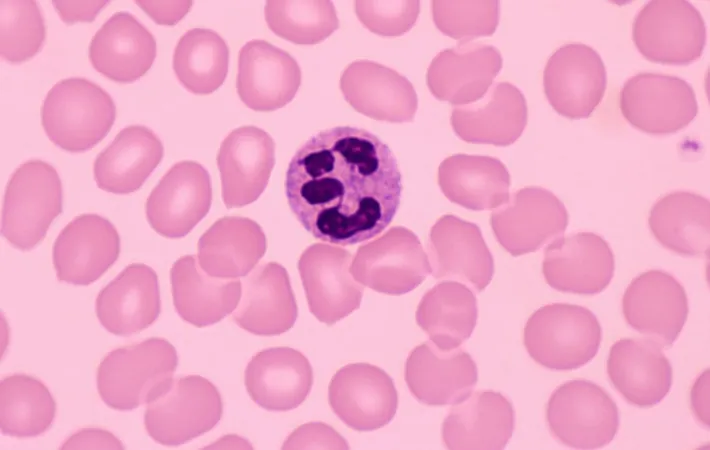
New Discoveries Reveal Neutrophils as Key Players in Skin Health
2025-03-26
Author: Daniel
In a groundbreaking study, researchers at Yale School of Medicine have unveiled a surprising new function of neutrophils, the most abundant immune cells in the human body. Traditionally recognized for their roles in combating infections and causing inflammation, neutrophils also significantly contribute to the development and maintenance of healthy skin. This discovery was published in *Nature* on March 19 and has sparked excitement in the field of immunology.
Lead author Alaz Ozcan, a postdoctoral associate at Yale, emphasizes that neutrophils are typically seen only as defenders against infections. However, this research highlights their presence in healthy tissues and their crucial role in preserving those tissues' integrity. The study showed that neutrophils not only inhabit healthy, uninfected skin but also produce extracellular matrix—a crucial network of proteins that provides structural support to skin cells.
The researchers observed that neutrophils enhance skin strength by secreting key extracellular matrix proteins, including collagen and fibronectin. Previously, this functionality was largely attributed to fibroblasts, the connective tissue cells commonly associated with tissue support. “Neutrophils are a bit like a jack of all trades,” remarks Andrés Hidalgo, a professor of immunobiology at Yale and a principal investigator of the study. “They are adaptable and capable of taking on new roles, such as building skin matrix.”
The Circadian Rhythm of Skin Health
An intriguing aspect of this study is the relationship between neutrophils and the circadian rhythm—our body's internal clock. Neutrophil levels fluctuate throughout the day, peaking during waking hours. Co-lead author Tommaso Vicanolo discovered that these fluctuations correspond with changes in mouse skin stiffness, which nearly doubled from night to day. Hidalgo suggests that increased skin toughness during waking hours may provide a survival advantage, including better protection from environmental stressors.
Although these findings were based on mice, the researchers believe similar mechanisms might exist in humans. They found neutrophils involved in producing the extracellular matrix in human skin tissue samples, suggesting that the dynamics observed in mice could extend to human biology.
Now, why does this matter? The implications for skin health are enormous. A robust structural integrity, bolstered by neutrophils, acts as a strong barrier against pathogens. When neutrophils are insufficient, skin loses its stiffness, becoming more permeable and vulnerable to infections. This is particularly concerning for immunocompromised individuals who rely heavily on neutrophils for both defending against pathogens and aiding wound healing.
As Hidalgo notes, “A weakened immune defense not only undermines the response to infections but can also delay the healing of skin wounds, since the same immune cells responsible for producing necessary matrix proteins may be compromised.”
A New Perspective on Immune Function
The study inspires a reevaluation of how we perceive immune cells. Beyond their conventional definitions, neutrophils might be performing a myriad of unexpected roles. This revelation opens exciting avenues for potential therapeutic strategies that can harness neutrophils’ diverse capabilities.
Ozcan's enthusiasm captures the spirit of this research: “Neutrophils not only fight infections; they build and protect our skin! This challenges our understanding of what these cells can do.”
In summary, the study signifies a substantial paradigm shift in immunology. Neutrophils are not just defenders; they are active architects of skin health—truly, “neutrophils are awesome.” As research progresses, we may uncover even more about these multifunctional cells and how they shape our overall health and resilience.




 Brasil (PT)
Brasil (PT)
 Canada (EN)
Canada (EN)
 Chile (ES)
Chile (ES)
 Česko (CS)
Česko (CS)
 대한민국 (KO)
대한민국 (KO)
 España (ES)
España (ES)
 France (FR)
France (FR)
 Hong Kong (EN)
Hong Kong (EN)
 Italia (IT)
Italia (IT)
 日本 (JA)
日本 (JA)
 Magyarország (HU)
Magyarország (HU)
 Norge (NO)
Norge (NO)
 Polska (PL)
Polska (PL)
 Schweiz (DE)
Schweiz (DE)
 Singapore (EN)
Singapore (EN)
 Sverige (SV)
Sverige (SV)
 Suomi (FI)
Suomi (FI)
 Türkiye (TR)
Türkiye (TR)
 الإمارات العربية المتحدة (AR)
الإمارات العربية المتحدة (AR)